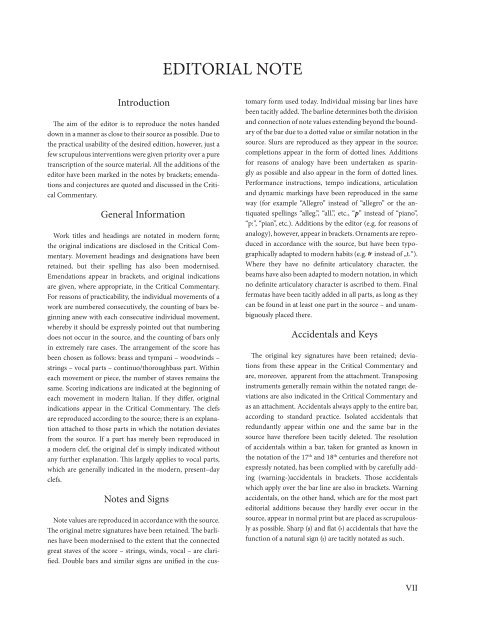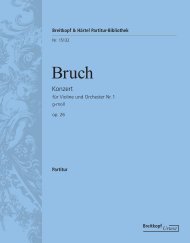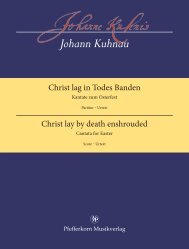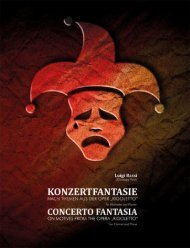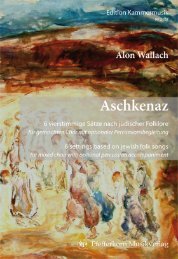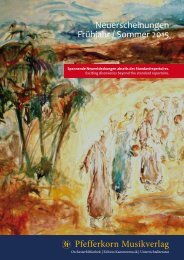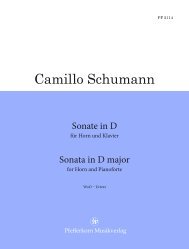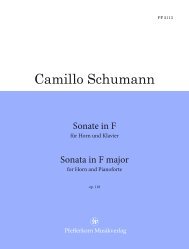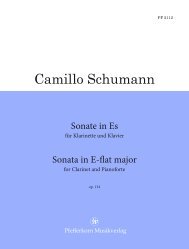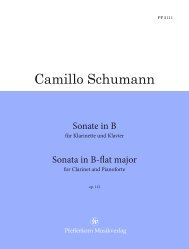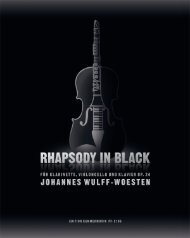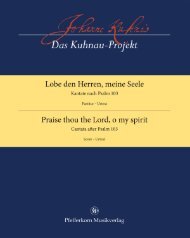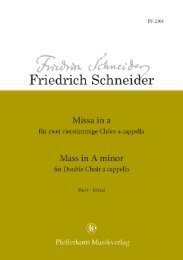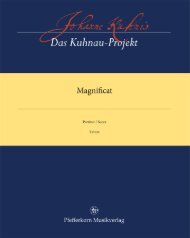PF-2093
Johann Kuhnau: Es steh Gott auf Kantate zum Osterfest Das Kuhnau-Projekt, Herausgegeben von David Erler
Johann Kuhnau: Es steh Gott auf
Kantate zum Osterfest
Das Kuhnau-Projekt, Herausgegeben von David Erler
Erfolgreiche ePaper selbst erstellen
Machen Sie aus Ihren PDF Publikationen ein blätterbares Flipbook mit unserer einzigartigen Google optimierten e-Paper Software.
EDITORIAL NOTE<br />
Introduction<br />
The aim of the editor is to reproduce the notes handed<br />
down in a manner as close to their source as possible. Due to<br />
the practical usability of the desired edition, however, just a<br />
few scrupulous interventions were given priority over a pure<br />
transcription of the source material. All the additions of the<br />
editor have been marked in the notes by brackets; emendations<br />
and conjectures are quoted and discussed in the Critical<br />
Commentary.<br />
General Information<br />
Work titles and headings are notated in modern form;<br />
the original indications are disclosed in the Critical Commentary.<br />
Movement headings and designations have been<br />
retained, but their spelling has also been modernised.<br />
Emendations appear in brackets, and original indications<br />
are given, where appropriate, in the Critical Commentary.<br />
For reasons of practicability, the individual movements of a<br />
work are numbered consecutively, the counting of bars beginning<br />
anew with each consecutive individual movement,<br />
whereby it should be expressly pointed out that numbering<br />
does not occur in the source, and the counting of bars only<br />
in extremely rare cases. The arrangement of the score has<br />
been chosen as follows: brass and tympani – woodwinds –<br />
strings – vocal parts – continuo/thoroughbass part. Within<br />
each movement or piece, the number of staves remains the<br />
same. Scoring indications are indicated at the beginning of<br />
each movement in modern Italian. If they differ, original<br />
indications appear in the Critical Commentary. The clefs<br />
are reproduced according to the source; there is an explanation<br />
attached to those parts in which the notation deviates<br />
from the source. If a part has merely been reproduced in<br />
a modern clef, the original clef is simply indicated without<br />
any further explanation. This largely applies to vocal parts,<br />
which are generally indicated in the modern, present–day<br />
clefs.<br />
Notes and Signs<br />
Note values are reproduced in accordance with the source.<br />
The original metre signatures have been retained. The barlines<br />
have been modernised to the extent that the connected<br />
great staves of the score – strings, winds, vocal – are clarified.<br />
Double bars and similar signs are unified in the customary<br />
form used today. Individual missing bar lines have<br />
been tacitly added. The barline determines both the division<br />
and connection of note values extending beyond the boundary<br />
of the bar due to a dotted value or similar notation in the<br />
source. Slurs are reproduced as they appear in the source;<br />
completions appear in the form of dotted lines. Additions<br />
for reasons of analogy have been undertaken as sparingly<br />
as possible and also appear in the form of dotted lines.<br />
Performance instructions, tempo indications, articulation<br />
and dynamic markings have been reproduced in the same<br />
way (for example “Allegro” instead of “allegro” or the antiquated<br />
spellings “alleg.”, “all.”, etc., “p” instead of “piano”,<br />
“p:”, “pian”, etc.). Additions by the editor (e.g. for reasons of<br />
analogy), however, appear in brackets. Ornaments are reproduced<br />
in accordance with the source, but have been typographically<br />
adapted to modern habits (e.g. Ÿ instead of „t.“).<br />
Where they have no definite articulatory character, the<br />
beams have also been adapted to modern notation, in which<br />
no definite articulatory character is ascribed to them. Final<br />
fermatas have been tacitly added in all parts, as long as they<br />
can be found in at least one part in the source – and unambiguously<br />
placed there.<br />
Accidentals and Keys<br />
The original key signatures have been retained; deviations<br />
from these appear in the Critical Commentary and<br />
are, moreover, apparent from the attachment. Transposing<br />
instruments generally remain within the notated range; deviations<br />
are also indicated in the Critical Commentary and<br />
as an attachment. Accidentals always apply to the entire bar,<br />
according to standard practice. Isolated accidentals that<br />
redundantly appear within one and the same bar in the<br />
source have therefore been tacitly deleted. The resolution<br />
of accidentals within a bar, taken for granted as known in<br />
the notation of the 17 th and 18 th centuries and therefore not<br />
expressly notated, has been complied with by carefully adding<br />
(warning-)accidentals in brackets. Those accidentals<br />
which apply over the bar line are also in brackets. Warning<br />
accidentals, on the other hand, which are for the most part<br />
editorial additions because they hardly ever occur in the<br />
source, appear in normal print but are placed as scrupulously<br />
as possible. Sharp () and flat () accidentals that have the<br />
function of a natural sign () are tacitly notated as such.<br />
VII


